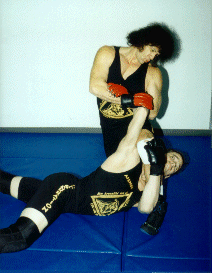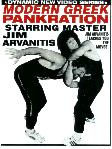|
|
In
Mu Tau Pankration, a unique ranking system consisting of ten grade
levels (abbreviated as GL) is utilized. A board of officials, assigned
by the United Pankration Alliance (UPA) controls all teaching
certifications. The ranking levels recognized are (from highest to
lowest):
| Keereeos (Creator/Innovator/Patriarch) |
| Master (GL10) |
| Senior Instructor/Professor (GL9) |
| Instructor (GL8) |
| Assistant Instructor (GL7) |
| Advanced (GL5-6) |
| Intermediate (GL3-4) |
| Novice (GL1-2) |
All ranks are authorized by a
Certificate issued by the United Pankration Alliance (the
governing body of Mu Tau Pankration) with the signatures of the
student's immediate instructor and that of a senior instructor. Grade
levels 9-10 are based solely on the approval of Grand Master pankratiast
Jim Arvanitis. It usually requires 7 years of training to attain the
rank of instructor (GL8), and at least 15 years to achieve Senior
Instructor level
Pankration bouts
Pankration bouts may only take
place between members of recognized Pankration organizations. The UPA
(United Pankration Alliance), founded by "The Father of Modern
Pankration" Jim Arvanitis, is the official U.S. representative
body.
There are three types of
Pankration competitions. Each differs from the other in the rules and
allowance of techniques.
CLASSIC
OLYMPIC PANKRATION
This competitive form allows
any means of attacking one's opponent with the exception of biting and
gouging. It is the original sport of the Olympics of 648 B.C. A contest
continues uninterrupted until either a knockout or submission is
reached.
SPARTAN
PANKRATION
The Spartans practiced a
fierce, no-holds-barred form of competitive combat. It allowed every
offensive technique with the objective to render one's adversary either
helpless or senseless.
MODERN
SPORT PANKRATION®
"Modern Sport
Pankration" encourages the use of both "ano" and "kato"
skills, with an equal emphasis on standing and ground fighting, as well
as striking and grappling techniques. The following rules are a subset
of those that apply to all contemporary "all-powers" bouts
sanctioned by the UPA , and are inspired by the ancient event with added
safeguards to make this form of pankration more acceptable for
"reality-based" competition in the modern world.
*A written test on Pankration
history must be completed and passed prior to being allowed to compete.
*Note that this form of competition is FULL-CONTACT only.
Mandatory Protective Gear:
- 8-ounce open-finger gloves
with dense foam knuckle padding (spheres)
- Full-face head guard with
poly-carbonate (clear) face cage
- Neoprene knee pads
- Soft foam shin pads
- Mouthpiece
- Groin protector
- Lightweight wrestling shoes
Competing Pankratiasts are
expected to fight barechested and wear thigh length spandex shorts.
Opening Spartan salutation must be made to one's opponent and to the
contestant's corner.
Legal Techniques:
ANO PANKRATION
- All punches to the head
and body
- Kicks to the legs, body
and head
- Knee strikes to the head
and body
- Sweeps
- Takedowns and throws
(including suplexes)
- Clinching the waist and
neck
- Any standing submission
hold or choke
- Any block, parry, or
evasion to defend against blows
- Any reversal of a
takedown or throwing attempt
KATO PANKRATION
- Punching to the body
- Kicking to the body and
legs
- Knee strikes to the body
- Any form of mounting
- Chokes (arm-throttling
and gripping with hands, or applying pressure with any other part
of the body)
- Any submission joint lock
(elbow, ankle, knee, finger, toe, etc.)
- Neck cranks, chin locks,
etc.
- Any reversal or escape
from a hold
Illegal Techniques:
- Gouging or poking the eyes
- Biting
- Striking to groin, kidney,
spine, and back of the head
- Strikes to head or face (on
ground)
- Headbutting
- Elbowing
- Hitting to the head when on
the ground
- Hairpulling
- "Fish-hooking"
(putting fingers in opponent's mouth)
- Pinching
- Scratching
- Tearing or pulling the ear
- Kicking to the knee joint
- Stomping with the foot on
the feet, face, or body
- Avoiding opponent/running
out of "arena"/refusal to fight
- Unsportsmanlikebehaviour
- Pulling on the cage of the
headguard
- Rude or belligerent
behavior including foul language
- Any competitor suspected or
found of consuming any illegal substances for performance
enhancement prior to competition will be suspended for no less than
six (6) months.
- Throws involving torqueing
of the neck or any joint.
Bouts can be won via knockout,
submission, or points.
UPA members may inquire about
purchasing a full length rules booklet. Topics covered include:
- The point system
description
- Referee requirements
- Judges' requirements
- Ring requirements
- Event promoter requirements
- And many more related
topics
GREEK
PANKRATION RULES
AMATEUR RULES
Classifications
Pankratiasts are classified
based on U.F.C.F. Pankration experience, wrestling, jiu jitsu,
muay thai, kickboxing, boxing, and other martial experience. The
following guidelines may be over ridden based on the above listed
experience & skill.
Novice class: 0 - 2
fights
C class: 3 -5 fights with minimum 1 win at novice class.
B class: 6 - 9 fights with 2 or more wins at C class.
A class: 10 + fights with 2 or more wins at B class.
Required safety gear &
uniform
Safety Gear
Approved shooting style gloves,
approved shin n instep pads ( pull on type ), approved knee pads, cup,
mouthguard, optional - Neoprene or cloth ankle supports can be worn to
support a previous injury but the injury must be verified by the
ringside physician & the supports must be approved. Taping of
previously injured areas will be under the same conditions stated
above.
Uniform
- Approved shooting style
gloves are mandatory
- Pankratiasts fight bare
top without Gi's or other top apparel.
- Full length tights or
bicycle length tights shall be worn on the lower half of the body.
- Knee pads are required
& must be approved thickness & density.
- Shin n instep ( pull on
type ) pads must be approved for thickness and density as well as
proper fit. They must provide maximum softness with enough density
so that when a thumb is pressed into them the shin and knee bones
cannot be felt through them with strong pressure applied. Pads
must fit snugly so that they will not easily pull down or move
around during competition.
- Fighters must wear a cup.
If the fighter wears an outer cup it must cover only the groin
& lower bladder area, it cannot extend out around the hip
area. Outer cups must be approved.
Illegal Techniques
All classes
- Head butts are illegal
- Closed fist to the head
of a downed opponent is illegal
- Striking with the elbows
is illegal
- Groin strikes are illegal
- Straight palm strikes to
the head of a downed opponent are illegal
- Kicks and knee strikes to
a downed opponent are illegal
- Striking the throat is
illegal
- Pulling hair is illegal
- Poking or gouging the
eyes is illegal
- Biting is illegal
- You may not throw an
opponent onto their head or neck
- Heel hooks are illegal
- Grabbing the ring ropes
or corner pads is illegal
- Pinching is illegal
(intentional)
- Scratching is illegal
(intentional)
- Striking the side and or
front of the knee is illegal
- Knee strikes to the head
are illegal
- Finger & toe
submissions are illegal
Additional Illegal
- Fighters may not use any
slippery substance on their body such as vaseline or linament.
Legal Techniques
All classes
- Kicking the head, legs
and body is legal (both fighters standing)
- Punching the head, body,
and legs is legal (both fighters standing)
- Take downs are legal
(with exceptions noted in illegal techniques section)
- Submission, joint locks,
chokes and pressure point techniques are legal except as noted
under illegal section
- Knee strikes to the body
and legs are legal (while both standing)
- Punching the body while
on the ground is legal
-----------------------------------------------------------------------
Grandmaster
Pankratiast Jim Arvanitis (a.k.a Keereeos) displaying the finer
points of Mu Tau.

As a fighting art of
antiquity, the importance of pankration goes without saying. Although
many of its techniques can be found readily in other indigenous
systems of the world, pankration was certainly the first combat method
to incorporate a complete array of fighting techniques, including
ground tactics, in its repertoire. Besides the legacies left by
pankration to the Western sports world, namely boxing and Greco-Roman
wrestling, a modern derivation of the classic "all-powers"
fighting style would also emerge.
Pankration was introduced to
the American martial arts community in the early 1970's by
Greek-American Jim Arvanitis, who had been trained from childhood in
Greco-Roman Combat Grappling and boxing techniques. Due to his strong
ethnic ties, Arvanitis would also spend most of his life studying and
researching the history and concepts of pankration. Arvanitis later
became proficient in muay-Thai (Thai kickboxing), Boxe Francaise
Savate (French foot-fighting), and combat judo. He then extracted the
optimum theories and skills from these sources, and synthesized them
into a cognate form. Called Mu Tau Pankration or MTP for short,
Arvanitis' system integrates modern techniques with the roots of the
ancient pankration. Designed solely for unrestrained street combat, it
combines submission grappling and ground-fighting skills with
kickboxing. He based his modern pankration style on leverage and
technical efficiency rather than brute strength. The student of this
exclusive hybrid is a well-rounded fighter, one who is skilled as
either a striker or grappler, and effective waging combat either
upright or on the ground, where most real fights will end up. Although
many are now claiming to be practicing pankration, the fact remains
that Arvanitis was the very first to revive the ancient form,
transform it into a contemporary "cross-training" art, and
popularize it around the world.
In the 1970s and early 80s,
Arvanitis would continue the tradition of his ancestors by competing
in Golden Gloves boxing and intercollegiate wrestling. He also was
undefeated in no-holds-barred street fights and impromptu challenge
matches against other martial arts stylists. In 1973, pankration was
first exposed to the American martial arts community when Arvanitis
was featured on the cover of Black Belt magazine. Since that time, he
has appeared in over 200 articles in newspapers and the top
international self-defense publications. He also stars in a number of
instructional video tapes. Jim's incessant accomplishments as an
author, historian, athlete, and high-profile instructor has made him
the most famous martial artist of Greek lineage and leading
pankratiast of the Twentieth century. The art of pankration and the
name Jim Arvanitis have indeed become synonymous.
Today, the influence of
pankration is clearly visible in modern combative competitions
stressing a "limited rules" environment. Several pankration
organizations throughout the European continent sponsor events on an
on-going basis for practitioners. Ironically, in Greece itself, the
authentic Hellenic martial artists following the "old ways"
are training in small backyard contingents. There is little, if any,
cohesion between these groups. It is the goal of the UPA (United
Pankration Alliance), founded by Jim Arvanitis, to organize these
proponents under its direction.

It is without question that
Greece's passion for martial arts has a long and proven history. From
the arenas of the first Olympic games and the legends that rivaled the
mythology of the gods, to its current practice as an unrestricted
combat form for today's rings and streets, pankration reigns as one of
the most formidable and comprehensive fighting styles that has ever
existed. Thanks to the efforts and innovations of its foremost
resource, Jim Arvanitis, its legacy lives on.
|
|